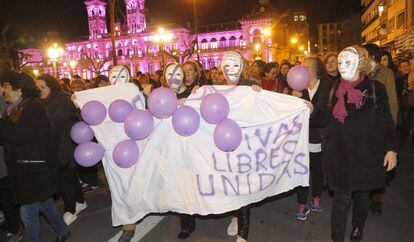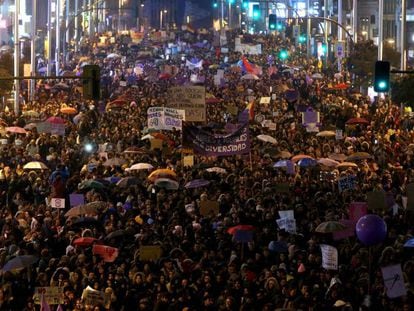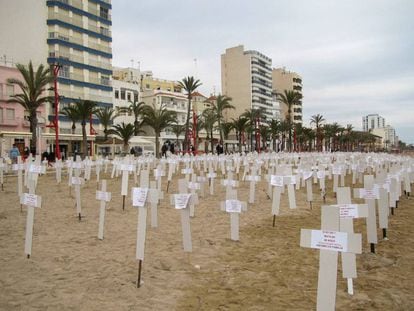Why Women’s Day was such a runaway success in Spain
On March 8 there was a general strike and an unprecedented demonstration that trumped those in all other countries. Experts explain why things were different this year


“I was in Madrid with my granddaughter that day. I couldn’t go to the demonstration because my legs aren’t what they used to be, but I would have loved to have been there,” says María Vargas del Río. “If I reflect on my life, I see women have it better now, but there is still a lot of male chauvinism. I have worked all my life both inside and outside the home. We cook, we iron, we clean, we look after everyone, and that has never been appreciated. What is happening now is exciting. Women are tired of being trampled.”
At 83, María is the antithesis of an activist. She lives in Bélmez de la Moraleda, a village of 1,600 residents in the Andalusian province of Jaén, and like so many women her age she has dedicated her life to working and tending to her family’s needs. What is happening now could, she feels, herald a profound shift in the status quo.
Hundreds of protests took place across the country in a general 24-hour strike, and the march’s success placed Spain at the cutting edge of the global movement
Scarcely five years ago, the March 8 demonstrations were fringe events. Most of the hundreds of thousands who gathered this year on the streets of their respective cities around Spain were marking International Women’s Day for the first or second time in their lives.
Last year the turnout was good, but this year it was overwhelming, with hundreds of protests taking place across the country, a general 24-hour strike (the only one in the world), partial walkouts by five million workers, and massive demonstrations of hundreds of thousands of people. Its success placed Spain at the cusp of a global movement.
Women and men of all political persuasions, nationalities and sexual orientation moved as one and made more noise than anywhere else in the world. The question is, why? What exactly is happening here? There is no clear answer yet, but feminists, historians and political scientists agree on a handful of likely contributing factors.

Gallardón and the attempt to change abortion laws
On February 1, 2014, tens of thousands of women came out to protest against an abortion reform bill that the Popular Party (PP)’s then-justice minister, Alberto Ruiz-Gallardón, was trying to push through to reverse existing legislation from 2010 allowing abortion on demand in the first trimester. It was the first time in decades that women had marched together in force, arriving by various modes of transportation in what has subsequently been dubbed the Freedom Train. Old slogans were heard once more: “Nosotras parimos, nosotras decidimos” (We give birth, we decide), and: “Decriminalize abortion!”
“That was the first sign that something was on the move again,” says Justa Montero, a militant feminist since the 1970s and one of the prime drivers of the March 8 strike. “The PP rekindled something unstoppable – young women rose up to shout that the rights they had won were non-negotiable.”
The demonstration was effective. Most Spaniards were in favor of maintaining the 2010 abortion law and the PP, which was not in a strong congressional position at the time, was aware of it. The reform was dropped and Ruiz-Gallardón resigned.
“That response to abortion [rights] didn’t come out of nowhere,” says Sílvia Claveria, a lecturer in political science at Madrid’s Carlos III University and an editor at Politikon, a Spanish think tank. “Three years earlier, the Indignados movement had been relevant to the creation of networks between young women. ‘The revolution will be feminist or it won’t happen at all’ is one of the slogans that was chanted with increasing fervor. The abortion demonstrations were successful because of the groundwork that had been laid silently over a long period of time.”

Flagging up gender violence
Another element peculiar to Spain is the importance that gender violence has been given over recent years. Just 15 years ago, the subject was barely spoken about in public. Disturbed by the lack of available statistics, in 2003 El PAÍS journalist Charo Nogueira and archivist Mercedes Chulia began to compile accounts of women killed by their partners and ex-partners. Since then, there has been a change in attitude by the media, politicians and the judiciary, and gender violence has gone from a domestic issue to a pressing social problem.
It is not that Spain has more gender abuse than elsewhere – the homicide rate, for example, is low compared to other European countries – but Spain has put the issue near the top of the political agenda. The Socialist Party administration of José Luis Rodríguez Zapatero (2004-2011) went as far as to set up a Ministry of Equality and a committee to fight gender abuse. “The media has also been a key factor,” says political scientist Claveria. “Especially the emergence of a type of journalism with a gender-sensitive approach and the message that this kind of violence is intolerable. It put gender violence under the microscope and analyzed it.”
The mobilizations against gender violence have gathered momentum in recent years. The last, on November 25, brought together thousands of women in more than 50 Spanish cities. But it was about more than domestic violence: rape and what constitutes it was also discussed, in the wake of the La Manada case – involving a group of five youths arrested for the sexual assault of an 18-year-old girl at the popular San Fermín festival in Pamplona in 2016. The case ignited the indignation of many girls who were stirred into action for the first time.

La Manada case
Verónica Martínez Esquivel, a 17-year-old high school student from Madrid, was not a member of any specific feminist organization, but on November 17 she took to the streets to protest, too. She was incensed that a victim of gang-rape had been spied upon after the crime by a private detective hired by the defense, and that the detective’s claims that the victim was hanging out happily with her friends were going to be used against her at the trial.
“It struck me as outrageous that a report compiled by a detective who spied on the gang-rape victim and argued that the girl was [subsequently] leading a normal life was accepted [as evidence],” she says. “So if I’m raped and I then step out on the street, that will be used against me? That’s where you start to think that you can’t go out alone at night without being really scared, that you’re fed up of hearing sexist comments when you walk down the street, that the fact women are allowed into dance clubs for free is completely chauvinistic … and that you want it all to change.”
“The feminists are here!” shouted the crowd that day, in numbers that exceeded all expectations. One of the organizers, Julia Santos, a sociology and international relations student at Complutense University in Madrid, recalls how they were expecting 1,500 people at the most. “It was completely spontaneous and we didn’t expect big crowds,” she says. “Suddenly, tens of thousands of women began to show up. It exceeded any expectation we had; it was as though people had just been waiting for a chance to get out and express how fed up they were.”
The PP rekindled something unstoppable – young women rose up to shout that the rights they had won were non-negotiable Justa Montero
The response to La Manada case is cited by all the experts as one of the basic triggers for the success of March 8, a moment when the feminist organizations got together and stunned everyone with a strength of feeling that had been building up over time.
The economic crisis
A new era of protest has started after years of apathy, and people are now taking to the streets to express their discontent in a way that has not happened for a long time. “As in other moments in history, feminism runs parallel with other social movements,” says Carmen de la Guardia, a lecturer of contemporary history at Madrid’s Autonomous University and researcher at the University Institute of Women’s Studies. “From the 19th century, feminism has appeared every time there’s been a political crisis as a mechanism for solving problems. It happened in 1848 with industrialization, and in the 1960s and 1970s, and again now. In the case of Spain, the problems stemming from the crisis are obvious, and include the perception that traditional politics are no longer able to solve current challenges.”
Undoubtedly, the difference from other key moments in history is that now feminism is driving the demands for change, rather than tagging along.
“During the economic crisis, the budgets for politicians working towards equality and against gender violence were cut; advances towards equal paternity and maternity rights have been blocked… and this has had an impact on women’s expectations and mobilized them,” says Sílvia Claveria.
Rafaela Pimentel, a 57-year- old Spanish woman of Dominican descent who earns her living working in the domestic sector, has spent her entire life in women’s associations. She now belongs to Territorio Doméstico – one of the associations behind the strike – and has watched as women affected by the crisis have joined their meetings. “More care workers and cleaners started to turn up at the meetings, as well as their daughters, who are students,” she says. “And Spaniards and immigrants, pensioners with walking sticks living alone who can’t afford help on their pensions, and women who have stopped working to look after their children and their parents because they have no support whatsoever.”
Generations come together
Justa Montero, 62, has been a committed feminist all her life. In 1974, when she was just 19, Spanish women were starting to demand their rights in a society that denied them abortions and divorce and made it illegal for them to open a bank account without their husband’s permission. Discrimination was such that it was a real battle just to establish some basic rights. “Subsequently, many of the prime movers of this struggle made their way into the institutions,” she remembers. “They thought that would be the best place to change things, and that’s where feminism went into a period of crisis as a certain sector of women became less militant.”
Now, however, young women are getting organized via social media. “I began to realize at university that I was feeling intimidated in mixed gender meetings, that I had a lot of insecurities and that I felt judged,” says Julia Santos. “When I started to participate in women-only groups, it was much easier. I could see that I wasn’t useless, that I had things to say but that sexist attitudes didn’t make it easy to say them. We students are aware that real equality doesn’t exist yet, and there is still a lot to fight for: there are many couples in toxic relationships, education is not equal, and we don’t have to put up with being harassed, or having things explained to us, or having men occupy all the space. The network is strong because so much happens to us purely on account of being women.”
The emergence of gender-slanted journalism with the message that this type of violence is intolerable has put it under the microscope and analyzed it Sílvia Claveria
Higher education centers have also been instrumental, as gender studies have become increasingly common at Spanish universities. “The interest in the subject is incredible,” says De la Guardia. “The optional courses in gender studies have waiting lists. Future mathematicians, biologists, anthropologists, they all want to take them – people from very different academic backgrounds. Most are women, but the number of men is increasing. The students are very active. They participate in class and then they meet outside and set up feminist organizations. There is a lot of reflection on equality.”
Social networks and rural living
Social media have also played a crucial role, not just in Spain of course. By facilitating communication, they allowed March 8 to also triumph in small rural towns. María Calle, 30, lives in Cabrero, a village of 357 in Cáceres province. She is a social worker and a member of the regional association Valle del Jerte, with more than 1,000 members. “Previously, these kinds of associations helped women, particularly those from rural areas, to get out of the house. Now they are much more about activism. Feminism, equality and micro-acts of machismo are all discussed here. There are growing numbers of young people talking to mothers and grandmothers about these things. And Facebook has helped to connect women from different towns.”
The connections also extend beyond these small towns to the rest of the world because, at the end of the day, movements like #MeToo are global.
Mobilizing the professionals
“What has been happening is great, including the fact that many professionals have taken over, in the best sense of the word, our own activism and made it theirs,” says Montero. “Journalists, for example, have been very important in making March 8 visible.”
“Scientists and publishers and teachers have also joined in… even the Sahrawi women from the desert camps. It’s snowballed. Women everywhere have felt the call. And many have been very moved. Older women, who are used to receiving scant appreciation, cried on hearing the young women shout, ‘Without the grandmothers and their energy, the system would crash!’”
Women journalists were a case in point. Four women – Ana Requena, Marilín Gonzalo, Marta Borraz and Eva Belmonte – organized a small gathering of women from various media outlets. From that came a Telegram group that had more than 1,000 members in just a few hours. Now it has more than 2,500.
Many women believe that if things don’t go well for them at work after having a child it’s because they’ve done something wrong, that it is a personal problem
Many of the professionals are between 30 and 50 and grew up believing that significant discrimination against women didn’t exist anymore. Then, as mothers, they came up against the realities of the workplace, such as not getting promoted as fast as their male colleagues; meanwhile, back home, their domestic duties increased.
“Professionals have been the last group to join massively,” says political scientist Claviera. “But at the end of the day, they are the backbone of society. They are fundamental. They are women who have very little time to get organized and be militant due to their workload, but whose participation is essential. It’s great that there are activists, but the main thing is to reach those sectors that can crank up the pressure so that social dynamics can change for real. Reaching these women has been a triumph for the March 8 movement. Many women believe that if things don’t go well for them at work after having a child, it’s because they’ve done something wrong themselves, that it is a personal problem. These networks of women have offered them an alternative vision; this is not just happening to you, it is systematic, structural, and you can fight it.”
The overwhelming success of March 8 has caught everyone by surprise. “Everything that has been happening has exceeded all expectations,” says Santos. “Now it’s time for us to reflect – for us and for society as a whole. The message from women from all different backgrounds is clear: Let’s change please!”
English version by Heather Galloway.

